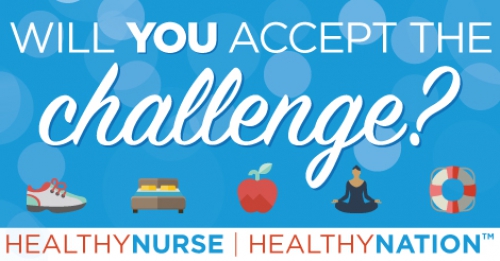Healthy Nurse, Healthy Nation™ Blog - Why Is It Hard To Eat Healthy?
Published
By Heather Moreno

Nutrition is a key, controllable factor affecting our health. But sadly, the CDC reports that most Americans don’t eat a healthy diet. Allowing for barriers to education and access to nutritious food, there’s still an alarming number of well-informed adults who eat poorly. Why doesn’t information equal healthy eating?
There’s no one answer, but several factors that affect our behavior. From all-or-nothing thinking to stress eating, or simply needing to grab-and-go, my clients are met with many challenges that make it hard to eat well.
For instance, take Karen, a busy RN case manager, who hits the local coffee drive-through on her way to work. At lunch, she’s called into a last-minute meeting, grabbing a donut from the break room. She arrives home after a long, hard day and eats a fairly healthy dinner with the family. She puts the kids to bed, then sits in front of the TV with her favorite snack to decompress. Rinse and repeat.
Karen’s smart. She wants to eat more fruits and vegetables and less foods from a box. She’s under no illusion that a donut makes for a healthy lunch. But change feels overwhelming. Especially when she reads that the American Heart Association recommends 4-5 servings of each fruits and vegetables per day, and she’s lucky to get one. Total!
Vary this scenario any number of ways and it’s the same. Smart, hard-working individuals are pulled in a lot of different directions, overwhelmed by commitments and worried about everything they’re doing wrong. Particularly when it comes to their health. So, how can one eat healthfully when faced with these obstacles?
One answer is to adopt the “small steps equal big results” philosophy. For instance, years ago I set out to start eating 5-6 servings of fruits and vegetables per day. But when I was honest, I was only eating 1-2. So, my initial goal was to eat a minimum of two per day. I did that for an entire month. Then, I spent three months getting comfortable with three per day. It took the better part of a year, but now I easily eat 5-6 servings daily. If I’d tried to triple my intake overnight (all-or-nothing thinking), I’d have been back at 1-2 in no time.
Perfectionism can also creep in after we’ve made a decision, like the afternoon donut. “What’s the use,” we say, “I’ve blown it already so I might as well…” Notice how there’s no good end to that thought. Instead, ask “What’s the best decision I can make with what’s in front of me right now?” Better questions elicit better health choices.
Another key is to address non-hunger eating. We eat for many reasons other than physical hunger, like boredom, stress and procrastination. It wouldn’t be bad if we simply ate a baby carrot or two. But we’re mostly snacking on highly processed foods. And lots of them.
I recommend to clients before they eat to ask, “Am I hungry?” This highlights times when you’re tempted to eat because, “it’s there,” “it looks so good” or you feel stress. In those moments when the answer is “no,” decide what to do instead. A good conversation with yourself can bring you back to what you really need in the moment. And it’s never food.
One more solution is to make healthy eating convenient. If your schedule is unpredictable, plan for it. Healthy, quick options abound, whether you carry them with you (I’m a fan of plant-based, whole food bars, nuts and apples) or know how to order when you’re eating out. Because my diet leans plant-based, my first choice is to look for meals with the most veggies, whole grains and legumes. Meat, dairy and highly processed breads are sparing, if at all. Consider substituting French fries with salad, meat with beans, and ask for condiments on the side. Request no cheese, more vegetables, less salad dressing. Any menu option can be made healthier. Have your goals in mind of how you want to eat. Know your options and be prepared. Then whatever you’re confronted with during your day, you have the ability to make a choice you feel good about. Physically and mentally.
Heather Moreno, MA, CPA, is a weight loss coach and owner of weightbreakthrough.com, who helps women stop agonizing over diets and break the patterns that hold them back from losing weight. Her greatest desire is for her clients to enjoy food, love life, and feel like themselves again.
Reviewed 12/14/22

Nutrition is a key, controllable factor affecting our health. But sadly, the CDC reports that most Americans don’t eat a healthy diet. Allowing for barriers to education and access to nutritious food, there’s still an alarming number of well-informed adults who eat poorly. Why doesn’t information equal healthy eating?
There’s no one answer, but several factors that affect our behavior. From all-or-nothing thinking to stress eating, or simply needing to grab-and-go, my clients are met with many challenges that make it hard to eat well.
For instance, take Karen, a busy RN case manager, who hits the local coffee drive-through on her way to work. At lunch, she’s called into a last-minute meeting, grabbing a donut from the break room. She arrives home after a long, hard day and eats a fairly healthy dinner with the family. She puts the kids to bed, then sits in front of the TV with her favorite snack to decompress. Rinse and repeat.
Karen’s smart. She wants to eat more fruits and vegetables and less foods from a box. She’s under no illusion that a donut makes for a healthy lunch. But change feels overwhelming. Especially when she reads that the American Heart Association recommends 4-5 servings of each fruits and vegetables per day, and she’s lucky to get one. Total!
Vary this scenario any number of ways and it’s the same. Smart, hard-working individuals are pulled in a lot of different directions, overwhelmed by commitments and worried about everything they’re doing wrong. Particularly when it comes to their health. So, how can one eat healthfully when faced with these obstacles?
One answer is to adopt the “small steps equal big results” philosophy. For instance, years ago I set out to start eating 5-6 servings of fruits and vegetables per day. But when I was honest, I was only eating 1-2. So, my initial goal was to eat a minimum of two per day. I did that for an entire month. Then, I spent three months getting comfortable with three per day. It took the better part of a year, but now I easily eat 5-6 servings daily. If I’d tried to triple my intake overnight (all-or-nothing thinking), I’d have been back at 1-2 in no time.
Perfectionism can also creep in after we’ve made a decision, like the afternoon donut. “What’s the use,” we say, “I’ve blown it already so I might as well…” Notice how there’s no good end to that thought. Instead, ask “What’s the best decision I can make with what’s in front of me right now?” Better questions elicit better health choices.
Another key is to address non-hunger eating. We eat for many reasons other than physical hunger, like boredom, stress and procrastination. It wouldn’t be bad if we simply ate a baby carrot or two. But we’re mostly snacking on highly processed foods. And lots of them.
I recommend to clients before they eat to ask, “Am I hungry?” This highlights times when you’re tempted to eat because, “it’s there,” “it looks so good” or you feel stress. In those moments when the answer is “no,” decide what to do instead. A good conversation with yourself can bring you back to what you really need in the moment. And it’s never food.
One more solution is to make healthy eating convenient. If your schedule is unpredictable, plan for it. Healthy, quick options abound, whether you carry them with you (I’m a fan of plant-based, whole food bars, nuts and apples) or know how to order when you’re eating out. Because my diet leans plant-based, my first choice is to look for meals with the most veggies, whole grains and legumes. Meat, dairy and highly processed breads are sparing, if at all. Consider substituting French fries with salad, meat with beans, and ask for condiments on the side. Request no cheese, more vegetables, less salad dressing. Any menu option can be made healthier. Have your goals in mind of how you want to eat. Know your options and be prepared. Then whatever you’re confronted with during your day, you have the ability to make a choice you feel good about. Physically and mentally.
Heather Moreno, MA, CPA, is a weight loss coach and owner of weightbreakthrough.com, who helps women stop agonizing over diets and break the patterns that hold them back from losing weight. Her greatest desire is for her clients to enjoy food, love life, and feel like themselves again.
Reviewed 12/14/22
Blog Nutrition
02/10/2020 5:33pm CST



Post a Comment or Question
CDC. (2018). Adult obesity facts. Retrieved from https://www.cdc.gov/obesity/data/adult.html.